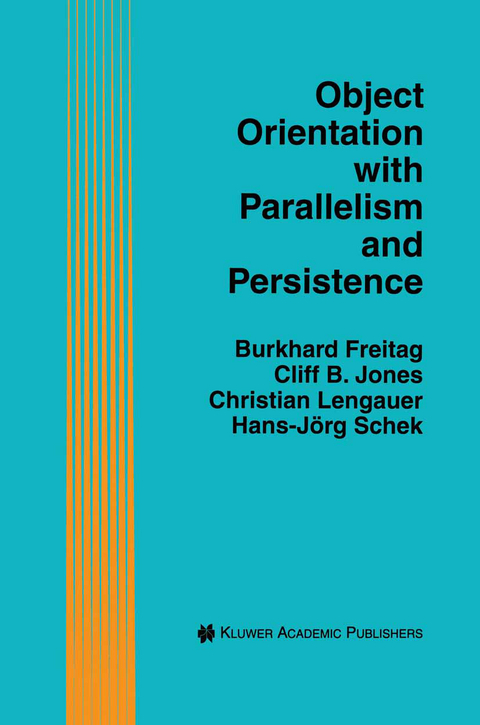
Object Orientation with Parallelism and Persistence
Springer-Verlag New York Inc.
978-1-4612-8625-7 (ISBN)
Object Orientation with Parallelism and Persistence will be of interest to researchers and professionals working in software engineering, programming languages, and database systems.
Both object orientation and parallelism are modern programming paradigms which have gained much popularity in the last 10-15 years. Object orientation raises hopes for increased productivity of software generation and maintenance methods. Parallelism can serve to structure a problem but also promises faster program execution.
The two areas of computing science in which these paradigms play the most prominent role are programming languages and databases. In programming languages, one can take an academic approach with a primary focus on the generality of the semantics of the language constructs which support the respective paradigm. In databases, one is willing to restrict the power of the constructs in the interest of increased efficiency.
Inter- and intra-object parallelism have received an increasing amount of attention in the last few years by researchers in the area of object- oriented programming. At first glance, an object is very similar to a process which offers services to other processes and demands services from them. It has, however, transpired that object-oriented concepts cause problems when combined with parallelism. In programming languages, the introduction of parallelism and the synchronization constraints it brings with it can get in the way of code reusability. In databases, the combination of object orientation and parallelism requires, for example, a generalization of the transaction model, new approaches to the specification of information systems, an implementation model of object communication, and the design of an overall system architecture.
There has been insufficient communication between researchers in programming languages and in databases on these issues. Object Orientation with Parallelism and Persistence grew out of a Dagstuhl Seminar of the same title in April 1995 whose goal it was to put the new research area `object orientation with parallelism' on an interdisciplinary basis.
Object Orientation with Parallelism and Persistence will be of interest to researchers and professionals working in software engineering, programming languages, and database systems.
1 Non-Interference Properties of a Concurrent Object-Based Language: Proofs Based on an Operational Semantics.- 1 Introduction.- 2 An Object-Based Language.- 3 Soundness of the Equivalences.- 4 Discussion.- References.- 2 Correct Transformational Design of Concurrent Search Structures.- 1 Introduction.- 2 A Concurrent Symbol Table.- 3 Mobile Processes.- 4 Translational Semantics of ????.- 5 I/O-Correctness.- 6 Conclusion.- References.- 3 Modal-?-Maude: Specification and Properties of Concurrent Objects.- 1 Introduction.- 2 Maude.- 3 The Modal ?-Calculus.- 4 Connections and Simulations.- 5 Inheritance of Properties.- 6 Abstraction and Verification.- 7 Relation to Other Work.- 8 Concluding Remarks.- References.- 4 An Object Model for Distributed and Concurrent Programming Based on Decomposition.- 1 Introduction.- 2 The Role of the Decomposition Hierarchy.- 3 State and Behaviour of Objects.- 4 Messages and Recursion.- 5 Inheritance.- 6 Summary and Future Work.- References.- 5 Objects and Classes, Co-Algebraically.- 1 Introduction.- 2 Algebras Versus Co-algebras.- 3 Examples of Co-algebraic Specification.- 4 Objects, Class Implementations and Class Specifications.- 5 Indistinguishability (Bisimulation) for Objects.- 6 Terminal Co-algebras Satisfying Assertions.- 7 Equations Between States?.- References.- 6 Semantic Refinement of Concurrent Object Systems Based on Serializability.- 1 Introduction.- 2 Related Work.- 3 An Event-Based Model for Object Systems.- 4 Action Refinement and Transaction Interleaving.- 5 Sequentialization of Event Structures and Refinement Criterion.- 6 Concluding Remarks and Future Work.- References.- 7 Unified Theory for Classical and Advanced Transaction Models.- 1 Introduction.- 2 Traditional Concurrency Control and Recovery.- 3 Our UnifiedModel.- 4 Unified Theory of the Read/Write Model.- 5 Unified Theory of Models with Semantically Rich Operations.- 6 Conclusion.- References.- 8 Coordination as Negotiated Transactions.- 1 Motivation.- 2 Rule-Based Coordination.- 3 Negotiation-Based Coordination.- 4 Related Work.- 5 Conclusion.- References.- 9 Role-Based Persistence.- 1 Introduction.- 2 Motivation.- 3 The Relationship Mechanism.- 4 Operations on Relationships.- 5 Derived Relationships.- 6 Role-Based Persistence.- 7 Comparison.- 8 Conclusion.- References.- 10 Design and Implementation of Process-Oriented Environments with Brokers and Services.- 1 Introduction.- 2 Requirements for a CPE Construction Formalism.- 3 The Broker/Services Model.- 4 Modeling CPEs with Brokers.- 5 Broker Implementation.- 6 Related Work and Concepts.- 7 Conclusion.- References.- 11 There’s Nothing Like Shared Nothing.- 1 Introduction.- 2 A Taxonomy of Parallel Database Architectures.- 3 A Brief History of Shared-Nothing.- 4 The Market Size for OOP&P.- 5 Parallel Computing and Relational Databases.- 6 Conclusions.- References.
| Reihe/Serie | The Springer International Series in Engineering and Computer Science ; 370 |
|---|---|
| Zusatzinfo | XIV, 233 p. |
| Verlagsort | New York, NY |
| Sprache | englisch |
| Maße | 155 x 235 mm |
| Themenwelt | Mathematik / Informatik ► Informatik ► Programmiersprachen / -werkzeuge |
| Mathematik / Informatik ► Informatik ► Software Entwicklung | |
| Informatik ► Theorie / Studium ► Algorithmen | |
| Informatik ► Theorie / Studium ► Compilerbau | |
| ISBN-10 | 1-4612-8625-5 / 1461286255 |
| ISBN-13 | 978-1-4612-8625-7 / 9781461286257 |
| Zustand | Neuware |
| Haben Sie eine Frage zum Produkt? |
aus dem Bereich


